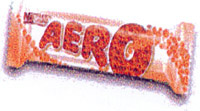
To settle an argument I was embroiled in, I wrote to Nestle to ask them about the history of Aero chocolate. They decided to send me a letter rather than an email (how quaint!), so while I was home and scanned and OCR’d it (so there may be a few character recognition errors). Here’s what they said….
Covering Letter#
1315171A 9 June 2004
Dear Andrew
Thank you for your recent enquiry concerning Aero.
As I am sure you will appreciate, we receive many requests for information and we are not always able to go into great detail on the varied and specific points raised. However, we enclose some leaflets which we hope you will find helpful.
If you have access to the internet please see our website www.nestle.co.uk where you will find more information which may be of help.
Thank you once again for taking the trouble to contact us and for the interest you have shown in our company.
Yours sincerely
Careline Advisor Consumer Services
Enclosed Literature#

History#
Aero was launched as ’the new chocolate’ by Rowntree in October 1935, at a cost of 2d.(old pennies). Initially it was available only in the North of England, distribution expanding throughout the UK the following year. By 1936 Aero had reached New York. It was one of the first products promoted by Rowntree primarily on the strength of the brand, rather than the company name.
Aero’s success owes much to its unique bubbly texture. From the first television advertising campaigns screened during the 1950s, the secret bubbly formula has proved a major success in providing the inspiration behind the ‘Lovely Bubbly Aero’ campaign.
Aero has undergone a series of developments in packaging, bar size and flavour, with the most significant innovations being the 1982 and 1996 relaunches. In 1982, the first countline Aero bar was introduced. This new ‘chunky’ bar resulted in sales of Aero almost doubling in the following few years. In 1996, Aero was reinvented as a light, indulgent bar marketed directly at the female chocolate consumer with the successful slogan ‘Float away with an Aero’. The traditional block Aero was redesigned to improve the breakage quality of the individual chunks. The wrappers of both the traditional and countline bars were redesigned in 1996, featuring a new Aero logo.
In August 1999, the Aero pack was redesigned again and a new TV ad featuring the Aero Hot GospeRers on air from September. The title of the gospel song, “Have you ever felt the bubbles melt?” is also the new strap line for Aero. It is reflected in improved pack graphics which feature an enlarged ‘O’ with a stream of chocolate bubbles issuing from it.
Production#
Aero bars, eggs and Christmas pies are all produced at the Nestle’ Rowntree factory in York. There are ten members and one shift leader in each production team and three shifts per day. Each shift produces approximately 11% -12 tonnes of chocolate. Aero production has improved in efficiency since more tonnage is now produced with ten people in a team than previously with 20 people in the team.
Output of Peppermint Aero tends to be greater than Milk Aero. The peppermint chocolate is harder and breaks less frequently than the softer, milk variety.
As well as seasonal products such as Aero Nflnt Eggs, approximately two to three times a year limited edition 300g and 600g Milk Aero and Peppermint Aero bars are produced.
The factory at York also produces Aero for the overseas market. This year has seen an increase in exports to Canada and Australia. Interestingly, the chocolate used to produce Aero for Australia is different from the UK market chocolate. To change from UK production to Australian production takes approximately four to five hours. It is acceptable to allow Australian chocolate to flow into UK chocolate, but not vice versa.
The Aero moulds automatically regulate production. If a solid bar is produced by mistake, it is rejected and replaced. It takes 17 minutes for the chocolate to reach the correct temperature for it to be deposited into the Aero moulds. The mould settings can be changed according to the different dosage of chocolate required for each particular size of bar.
The liquid chocolate then passes through a shaker to ensure that all the moulds are filled to the correct level. Aero production is not wasteful. If too much chocolate has been poured into the mould, it is recycled. The machine turns the moulds upside down to shake off any excess chocolate. Similar recycling processes occur throughout production.
The next stage of production is cooling. The chocolate shell must be stiffened before the centre is added. The cooling process takes approximately 20 minutes before the required temperature has been reached. The process is delicate since the chocolate shells must not be completely solidified. Also, they need to be warmed again slightly before the secret formula, bubbly centre can be added. The way in which the unique Aero bubbles are added is a top secret, patented process closely guarded by Nestle’ Rowntree.
Once this has been completed, the chocolate bars are once again passed through the shakers. This is to ensure the centre has been poured in evenly. The bar shakers are, however, less severe than the shell shakers.
The bars are then subjected to the licking roller. The roller removes the very top layer of the bar, leaving a quarter inch gap. This is necessary to ensure the back casing of the bar can be attached. The bars must enter a second cooler, again for twenty minutes. The back of the bar can now be added. The third and final cooling process ensures the back casing becomes hard. The chocolate is now tempered and will not turn white.
Often the bars leave the final cooler, they are twisted to ensure they are loose. A number of hammers are added to the twister to lift the bars from the moulds. Milk Aero bars which are soft must only be hammered once. But Peppermint Aero can take two or even three blows of the hammer due to its extra strength! The bars are now released and the moulds return to the very beginning of the production process.
Wrapping and packing#
Approximately three hundred and thirty Aero bars are wrapped per minute. The wrappers are then gummed and coded. The bars are then loaded into cartons. Aero destined for the UK market is packed into cartons containing two dozen bars. Aero cartons, which must travel to Australia, contain three dozen. Changing cartons between the UK and Australia takes about forty-five minutes! The machine itself must be changed when switching to produce Australian bars or Giant Aero. Whilst twenty-seven moulds can be processed per minute for traditional bars, Australian and Giant bars can only be produced in quantities of sixteen to seventeen moulds per minute.
Once the bars have been wrapped and stamped, they must pass through a metal detector. This is to ensure that no foreign bodies have entered the Aero products at any stage of the production process. The coding machine must be checked every fifteen minutes. If the labels have not been printed correctly, they cannot be sold!
Chronology#
- 1935 Launch of Aero in the North of England in October 1935.
- 1936 Aero launched across the UK and exported to New York.
- 1937 Acrobats used to advertise the new Nut Milk and Fruit & Nut Milk varieties of Aero.
- 1950s Television advertising launched for Aero.
- 1982 Aero countline bar introduced.
- 1999 Major relaunch of Aero.
Packs and varients#
- Aero Milk Chunky
- Aero Milk Medium
- Aero Peppermint Medium
- Aero Orange Medium
- Aero Milk Giant
- Aero Peppermint Giant
- Aero Mini Hanging Bags
Limited Editions#
- Aero White (launched 1999)
- Aero Cappuccino
- Aero Mint Egg (Easter; debut in 1996)
- Nut Aero
- Fruit & Nut Aero
- Strawberry Aero
- Lime Aero
Special Editions#
- Peppermint Aero (launched 1973)
- Orange Aero (launched 1974)
Extensions of Brand#
- Aero Milk Drinks
- Aero Mousse
- Aero Ice Cream (Peppermint Aero Ice Cream Chocolate Bar launched in 1996)
